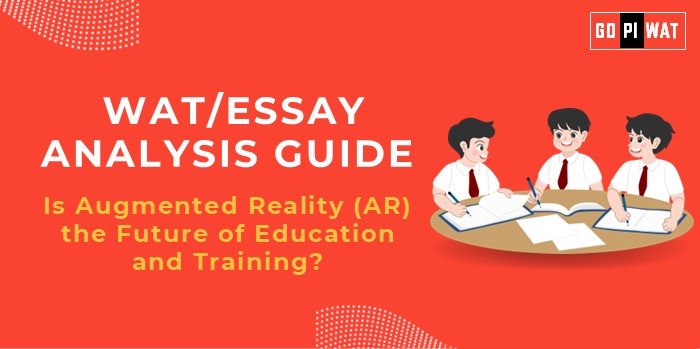📋 WAT/Essay Analysis Guide: Is Augmented Reality (AR) the Future of Education and Training?
🌐 Understanding the Topic’s Importance
Augmented Reality (AR) is reshaping education and training globally by enabling immersive learning experiences that go beyond traditional methods. Its growing adoption signals a shift towards more interactive, practical, and personalized education solutions, making it crucial for bridging skill gaps and preparing learners for the demands of a digital-first world.
📝 Effective Planning and Writing
- Time Allocation:
- Planning: 5 minutes
- Writing: 20 minutes
- Review: 5 minutes
- Preparation Tips:
- Gather key data on AR’s impact.
- Identify relevant case studies and examples of AR applications.
📖 Introduction Techniques
- Contrast Approach: “Traditional classrooms rely on passive teaching methods, whereas Augmented Reality (AR) transforms the learning environment into an engaging, interactive space that fosters better retention and understanding.”
- Solution-Based Approach: “Augmented Reality offers a solution to the limitations of conventional education by providing immersive experiences that bridge the gap between theory and practice, particularly in technical and professional training domains.”
- Timeline Approach: “From early experiments in virtual simulations to today’s AR-powered classrooms and training labs, the journey of Augmented Reality highlights its potential to revolutionize how we learn and work.”
📊 Structuring the Essay Body
- Achievements:
- Enhanced engagement and retention (e.g., studies show AR improves retention by 80%).
- Practical applications in STEM, medicine, and corporate training.
- Global case studies, such as Boeing reducing training time by 35% with AR tools.
- Challenges:
- High costs of AR hardware and software.
- Limited access in underprivileged regions.
- Resistance to adopting new technologies in traditional education systems.
- Future Outlook:
- Scaling AR through cost-effective mobile applications.
- Integration with AI for personalized learning.
- Partnerships to expand AR access in developing countries.
💡 Concluding Effectively
Balanced Perspective: “While AR’s potential to revolutionize education and training is immense, its true impact will depend on overcoming barriers such as cost and accessibility. Collaborative efforts among governments, tech companies, and educators are key to ensuring AR benefits all learners.”
Future-Focused Approach: “As AR continues to evolve, its applications in education and training will expand, paving the way for a more interactive, skill-oriented, and inclusive learning ecosystem.”
📈 Analyzing Successes and Shortcomings
- Key Achievements:
- Increased student engagement and retention.
- Hands-on training in critical fields like healthcare and aviation.
- Adoption in corporate environments, improving efficiency and performance.
- Challenges:
- High initial costs and infrastructure requirements.
- Lack of widespread teacher training and readiness.
- Inequalities in access due to the digital divide.
- Global Context:
- The USA and Finland lead in AR integration in education, offering valuable models for other countries.
- Developing nations are experimenting with mobile-based AR solutions to address cost challenges.
✨ Recommendations for Sustainable Progress
- Develop affordable AR tools, including mobile-based AR applications.
- Create teacher training programs focused on AR adoption and integration.
- Foster public-private partnerships to fund AR infrastructure and software development.
- Encourage global collaborations to share best practices and resources.
📄 Sample Short Essays
- Balanced Perspective (100 Words): “Augmented Reality (AR) is transforming education and training by offering immersive, interactive learning experiences that enhance engagement and retention. From medical simulations to corporate training, AR’s practical applications demonstrate its potential to revolutionize learning. However, challenges such as high costs, infrastructure limitations, and access inequalities persist, particularly in developing regions. To ensure AR’s success, stakeholders must prioritize affordability, teacher training, and global collaborations. With these efforts, AR can democratize education and equip learners with future-ready skills, making it a cornerstone of modern learning systems.”
- Solution-Oriented Approach (100 Words): “AR holds immense promise for transforming education and training by bridging theoretical and practical knowledge. While challenges such as high costs and limited access hinder its widespread adoption, innovative solutions like mobile AR applications and public-private partnerships can overcome these barriers. Training programs for educators and investments in affordable AR tools are critical. Global examples, such as Finland’s AR-enabled classrooms, highlight its potential to make learning more interactive and effective. By addressing these challenges, AR can redefine education, ensuring inclusivity and better learning outcomes for all.”
- Global Comparison Approach (100 Words): “While countries like the USA and Finland lead in AR adoption for education, developing nations face challenges such as high costs and limited access. AR’s potential to revolutionize learning through interactive and immersive experiences is undeniable, particularly in fields like STEM and professional training. To bridge the gap, global collaborations are essential, with developed nations sharing technology and best practices. Mobile-based AR solutions offer a cost-effective way to expand access in underserved regions. If implemented effectively, AR can democratize education, equipping learners worldwide with the skills needed for a dynamic future.”


